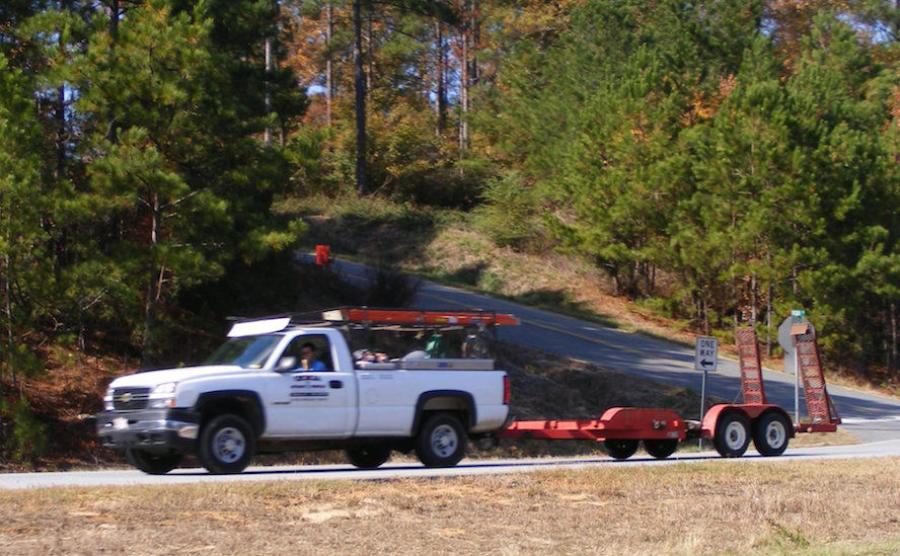
Fri September 08, 2017
Bob Raybuck -Director of Technical Services -NTEA
Trailer towing involves three primary elements: the work truck used to tow; the trailer and payload being towed; and towing system components (e.g., hitch system and safety chains). Each has limiting factors that directly affect maximum towing capability.
Truck salespeople, fleet managers and end users face challenges in determining size and capacity of the trailer that can be towed based on the work truck specified or purchased. First, let's review the tow vehicle's rating. Truck manufacturers publish maximum trailer tow rating and gross combined weight rating (GCWR) in the trailer towing guide or as part of the vehicle specification guide. Additionally, the trailer towing guide may include maximum trailer tow ratings based on conventional towing (which uses a coupling device attached to the rear of the towing vehicle) or fifth wheel towing (which utilizes a coupling device attached to the top of the chassis near the rear axle and is sometimes referred to as a gooseneck). Alternatively, medium- and heavy-duty truck dealers provide information based on the OEM order guide or through application engineering departments. The chassis manufacturer determines GCWR using a variety of factors, including specific drivetrain components of the engine, transmission, number of drive axles, axle ratios and braking capability. Each OEM tests chassis towing and stopping capability before determining vehicle GCWR.
Chassis manufacturers also provide maximum trailer weights for conventional and fifth wheel/gooseneck towing. Normally, these maximum trailer weights are for complete vehicles such as pickups and vans, and do not include work trucks built from incomplete chassis. Truck GCWR helps determine maximum trailer towing capacity. Both the weight of the towing vehicle and the trailer (towed vehicle) are included in the GCWR total. Essentially, vehicle trailer towing capacity is determined by remaining GCWR after taking into consideration chassis, truck body, equipment, passenger, fuel and payload weight. The amount of payload carried on the work truck can raise or lower maximum trailer towing capacity. For example, if your work truck has a 26,000-pound GCWR and 19,000-pound gross vehicle weight rating (GVWR) and is completely loaded to the GVWR, maximum trailer weight would be 7,000 pounds — even if the truck manufacturer stated the maximum trailer weight was 11,000 pounds.
The second element of trailer towing is trailer GVWR — the maximum allowed weight of the trailer and its payload, which can be found on the required trailer certification label. Typically, the certification label for a trailer is a metal plate welded or riveted to the forward half of the left front. Trailer GVWR will be based on the limiting factors of the axle(s), tires, frame, coupler and safety chains. The trailer manufacturer is required to take all components into consideration when determining final GVWR.
The third factor in trailer towing is the trailer coupling system, which contains the components necessary to connect the towing vehicle and trailer. Conventional trailer, fifth wheel and gooseneck towing systems are rated by SAE International Standards.
SAE J684 divides conventional-style (receiver hitch and ball) trailer hitch systems into four classes:
Conventional hitch manufacturers rate their receiver-style hitches using this capacity format. Some market Class 5 hitches up to 17,000 pounds; however, SAE J684 does not contain a rating for this class.
Pintle hook hitch system (another type of conventional coupling system) performance ratings are covered by SAE Recommended Practice J847. It does not specify rating classes similar to the automotive-style hitches in SAE J684, but it does provide a performance test for hitch manufacturers to ensure the pintle hook and corresponding draw bar will perform to their rated test capacities.
There are other factors to consider when determining actual vehicle maximum towing capacity. For example, coupling system capacity is determined by the weakest component in the system. Components in a conventional towing system include the receiver, draw bar, hitch ball and connecting pin. If the installed hitch is rated at a maximum of 10,000 pounds but the hitch ball is rated for 9,000 pounds, even though the hitch has a higher towing capacity of 10,000 pounds, the maximum trailer towing capacity is limited by the hitch ball's 9,000-pound rating.
When determining chassis specifications for towing with a work truck, it's important to fully understand the end user's body, equipment and payload needs. When assessing maximum truck towing capacity, it's also essential to account for correct matching of trailer hitch system components to the desired trailer and payload, since the hitch system can be a limiting factor for safety, durability and customer satisfaction.
Learn more
NTEA members have access to publications and reference materials on current regulations, safety standards, and other technical issues at ntea.com/technicalresources. To learn more about the tools, resources and solutions available to members, visit ntea.com/memberbenefits.
 Truck and Trailer Equipment
Truck and Trailer Equipment Articles
Articles Email Updates
Email Updates Sell Your Machines
Sell Your Machines

 Truck and Trailer Equipment
Truck and Trailer Equipment Truck and Trailer Dealers
Truck and Trailer Dealers Truck and Trailer Articles
Truck and Trailer Articles Email Updates
Email Updates Sell Your Machines
Sell Your Machines